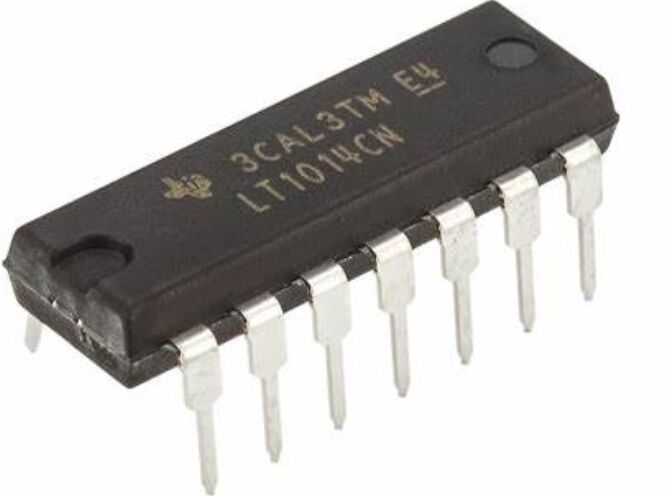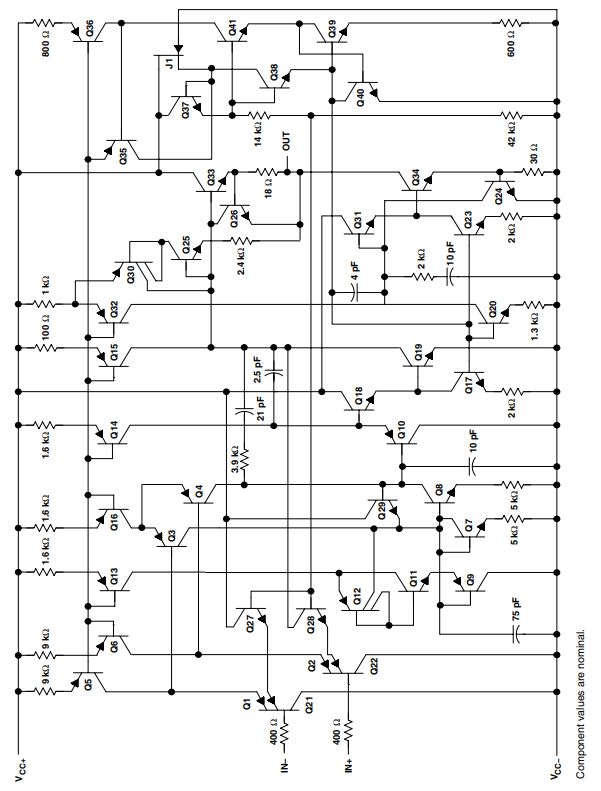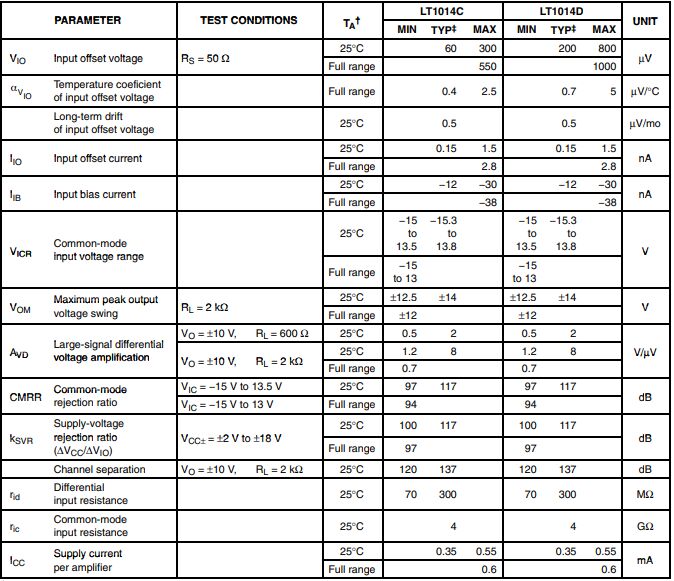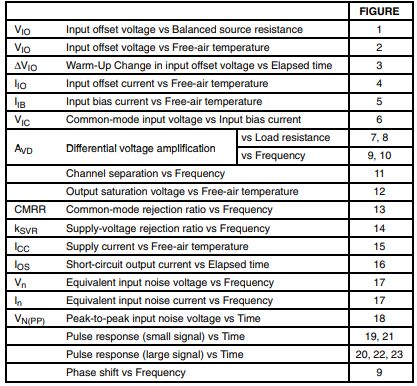By Texas Instruments 239
LT1014CN is a precision quad operational amplifier, specifically a four-channel operational amplifier. An operational amplifier is an integrated circuit used to amplify voltage signals. The LT1014CN features high accuracy, low offset current, and low input bias current. This makes it suitable for applications requiring high-performance amplifiers, such as precision instruments and data acquisition systems.
An operational amplifier is a type of integrated circuit usually used to amplify analog signals. They respond very quickly to changes in the input signal, have high gain, and are highly robust to temperature and process changes.
High accuracy means that the amplifier has very low errors and can provide accurate signal amplification. Low offset current means that the input current of the amplifier is very small in the balanced state, which helps reduce errors and noise. Low input offset Current means the amplifier has better sensitivity to small input signals and can better detect and amplify weak signals.
These features make the LT1014N particularly suitable for weak signal detection, high-precision measurements, and audio and video applications that require high dynamic range and low noise.

Ⅰ.Specification parameters of LT1014CN
•Number of channels:4Channel
•Number of pins:14
•Input compensation drift:400 nV/K
•Height:4.57 mm
•Length:19.3 mm
•GBP-gain bandwidth product:1MHz
•CMRR-Common Mode Rejection Ratio:117 dB
•SR-Slew Rate:400 mV/us
•Output current per channel:20 mA
•Ib-Input bias current:12 nA
•Vos-Input bias voltage:60 uV
•Supply voltage-maximum:30 V
•Supply voltage-minimum:4 V
•Pd-Power dissipation:1.15 W
•En-input voltage noise density:22 nV/sqrt Hz
•Minimum operating temperature:0℃
•Maximum operating temperature:+70℃
•Operating power supply current:350 uA
•Shutdown:No Shutdown
•Package/Case:PDIP-14
•Amplifier type:Precision Amplifier
•Dual supply voltage:+/- 15 V
•In—input noise current density:0.07 pA/sqrt Hz
•Maximum dual supply voltage:+/- 22 V
•Minimum dual supply voltage:+/- 2.5 V
•Operating power supply voltage:5 V to 44 V, +/- 2.5 V to +/- 22 V
•Slew rate:400 mV/μs
•Dissipated power (Max):1150 mW
•Common mode rejection ratio (Min):97 dB
Ⅱ.The role of LT1014CN
1.Signal amplification: LT1014CN is mainly used to amplify voltage signals. It can amplify weak signals input from the previous or subsequent cascade circuits and increase the amplitude to large enough so that subsequent circuits can effectively process these signals. The working principle of an operational amplifier is based on the differential voltage between its two input terminals, producing an output voltage with a gain factor between this output voltage and the input voltage. This gain factor is usually large, allowing the op amp to convert small changes in input voltage into significant changes in output voltage.
2.Multi-channel applications: LT1014CN is a four-channel operational amplifier that is very useful in applications that handle multiple independent signal channels. This allows each channel to independently amplify different input signals. This design makes it more flexible and convenient in applications such as multiplexing, signal separation, and analog circuit design. For example, in audio or video signal processing, a four-channel operational amplifier can be used to amplify the signals of different channels such as left, right, center, and surround respectively to achieve more precise audio or video effects. In a data acquisition system, a four-channel operational amplifier can be used to amplify signals from different sources, such as temperature, pressure, current, etc., and then transmit them to an ADC (analog-to-digital converter) for processing.
3.Instrument amplification: In scientific instruments, test equipment and meters, the LT1014CN can be used to provide precise amplification functions to ensure accurate measurement and data collection.
4.Signal conditioning: When performing signal conditioning, LT1014CN can be used as a general-purpose amplifier to amplify or reduce the input signal to meet the requirements of subsequent circuits. It can also be used as a buffer, isolating different parts of the circuit to reduce the interaction between them. In addition, LT1014CN can also be used to implement feedback links in analog circuits to improve system performance. When using the LT1014CN for signal conditioning, some key factors need to be considered, such as the amplifier's gain, bandwidth, noise performance, etc. Depending on the specific application requirements, some additional settings and adjustments may be required, such as filtering, balanced input and output, etc.
5.Data acquisition system: In systems that require precise measurement and data collection from multiple sensors or signal sources, LT1014CN can be used to amplify and process signals from different channels.
6.Filter: LT1014CN, often used to build various types of filter circuits. The main function of a filter is to allow or block signals in a specific frequency range from passing through. This is useful when pre- or post-processing a signal to improve its quality or characteristics. Using operational amplifiers such as the LT1014CN, various first- or second-order active filters can be designed. This filter type can be a low-pass, high-pass or band-pass filter. For example, a low-pass filter can be used to remove high-frequency noise from a signal, while a high-pass filter can be used to remove low-frequency noise from a signal. A bandpass filter allows signals in a specific frequency range to pass while suppressing signals in other frequency ranges.
7.Precision amplification: Because LT1014CN has the characteristics of high precision and low offset current, it is especially suitable for applications requiring high performance and precision amplification.
Ⅲ.Working principle of LT1014CN

1.Differential mode input: The operational amplifier has two input terminals, one is the positive input (+) and the other is the negative input (-). It is a differential mode amplifier, meaning it amplifies the voltage difference between the two inputs.
2.Feedback loop: Operational amplifiers usually stabilize and adjust amplification through feedback loops. Negative feedback is a common approach in which part of the output voltage is fed back to the negative input, thereby controlling the gain of the amplifier.
3.High gain: Operational amplifiers have very high voltage gains, usually reaching tens of thousands of times. This means it can amplify tiny voltage differences into a larger output voltage.
4.Virtual short circuit: Under differential mode input conditions, operational amplifiers usually have the characteristics of virtual short circuit, that is, it assumes that the voltage difference between the input terminals is zero. This means that the voltages at the negative and positive inputs are almost equal.
5.Channel independence: LT1014CN is a four-channel operational amplifier. Each channel is independent, so it can process multiple signals at the same time.
6.Power supply: LT1014CN requires external positive and negative power supplies to ensure normal operation.
IV.Pin layout diagram of LT1014CN

Ⅴ.Electrical characteristics of LT1014CN

Ⅵ.Frequency response of LT1014CN
Generally speaking, the frequency response of an op amp refers to the change in its gain at different frequencies. Frequency response can be affected by many factors, including internal capacitance, poles, and bandwidth. At high frequencies, the gain of an op amp typically decreases.
1.Consult the data sheet: The LT1014CN's data sheet or technical specification sheet will provide detailed electrical characteristics, including frequency response.
2.Look at the cutoff frequency: Focus on the cutoff frequency (3 dB point), which is the point on the frequency response curve where the gain drops to half the original gain. For some op amps, this is often called the bandwidth product.
3.Pay attention to the influence of load: When considering frequency response, the influence of load should also be considered. Load capacitance and resistance can affect op amp performance.
4.Pay attention to environmental conditions: In some cases, environmental conditions such as temperature and supply voltage may also affect frequency response.
Ⅶ.Typical Characteristics of LT1014CN

Frequently Asked Questions
1.What is the LT1014CN?
The LT1014CN is a precision quad operational amplifier (op-amp) produced by Linear Technology, now a part of Analog Devices Inc. It features four independent op-amp channels in a single package.
2.What is the typical power supply voltage range for LT1014CN?
The LT1014CN typically operates within a specified power supply voltage range.
3.In what kind of environments does LT1014CN excel due to its precision features?
The LT1014CN excels in applications requiring high precision due to its low input bias current and other precision characteristics. It is suitable for applications where accurate signal amplification is crucial.